Cbse Class 12 Maths Ncert Solutions Chapter 10
Home » Class 12 Math » NCERT Solutions for Class 12 Maths Maths Part-2 Chapter 10 Vector Algebra
Free NCERT Solutions for Class 12 Maths Chapter 10 Vector Algebra solved by Expert Teachers as per NCERT (CBSE) Book guidelines and brought to you by Toppers Bulletin. These Vector Algebra Exercise Questions with Solutions for Class 12 Maths covers all questions of Chapter Vector Algebra Class 12 and help you to revise complete Syllabus and Score More marks as per CBSE Board guidelines from the latest NCERT book for class 12 maths. You can read and download NCERT Book Solution to get a better understanding of all topics and concepts
10.1 Introduction
10.2 Some Basic Concepts
10.3 Types of Vectors
10.4 Addition of Vectors
10.5 Multiplication of a Vector by a Scalar
10.5.1 Components of a vector
10.5.2 Vector joining two points
10.5.3 Section formula
10.6 Product of Two Vectors
10.6.1 Scalar (or dot) product of two vectors
10.6.2 Projection of a vector on a line
10.6.3 Vector (or cross) product of two vectors.
Vector Algebra NCERT Solutions – Class 12 Maths
Exercise 10.1 : Solutions of Questions on Page Number : 428
Q1 : Represent graphically a displacement of 40 km, 30° east of north.
Answer :
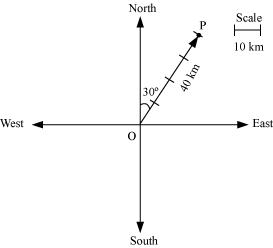 Here, vector
Here, vector![]() represents the displacement of 40 km, 30° East of North.
represents the displacement of 40 km, 30° East of North.
Q2 : Classify the following measures as scalars and vectors.
(i) 10 kg (ii) 2 metres north-west (iii) 40°
(iv) 40 watt (v) 10-19 coulomb (vi) 20 m/s2
Answer :
(i) 10 kg is a scalar quantity because it involves only magnitude.
(ii) 2 meters north-west is a vector quantity as it involves both magnitude and direction.
(iii) 40° is a scalar quantity as it involves only magnitude.
(iv) 40 watts is a scalar quantity as it involves only magnitude.
(v) 10-19 coulomb is a scalar quantity as it involves only magnitude.
(vi) 20 m/s2 is a vector quantity as it involves magnitude as well as direction.
Q3 : Classify the following as scalar and vector quantities.
(i) time period (ii) distance (iii) force
(iv) velocity (v) work done
Answer :
(i) Time period is a scalar quantity as it involves only magnitude.
(ii) Distance is a scalar quantity as it involves only magnitude.
(iii) Force is a vector quantity as it involves both magnitude and direction.
(iv) Velocity is a vector quantity as it involves both magnitude as well as direction.
(v) Work done is a scalar quantity as it involves only magnitude.
Q4 : In Figure, identify the following vectors.
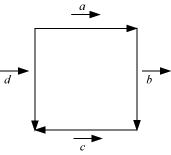
(i) Coinitial (ii) Equal (iii) Collinear but not equal
Answer :
(i) Vectors![]() and
and![]() are coinitial because they have the same initial point.
are coinitial because they have the same initial point.
(ii) Vectors![]() and
and![]() are equal because they have the same magnitude and direction.
are equal because they have the same magnitude and direction.
(iii) Vectors![]() and
and![]() are collinear but not equal. This is because although they are parallel, their directions are not the same.
are collinear but not equal. This is because although they are parallel, their directions are not the same.
Q5 : Answer the following as true or false.
(i)![]() and
and![]() are collinear.
are collinear.
(ii) Two collinear vectors are always equal in magnitude.
(iii) Two vectors having same magnitude are collinear.
(iv) Two collinear vectors having the same magnitude are equal.
Answer :
(i) True.
Vectors![]() and
and![]() are parallel to the same line.
are parallel to the same line.
(ii) False.
Collinear vectors are those vectors that are parallel to the same line.
(iii) False.
It is not necessary for two vectors having the same magnitude to be parallel to the same line.
(iv) False.
Two vectors are said to be equal if they have the same magnitude and direction, regardless of the positions of their initial points.
Exercise 10.2 : Solutions of Questions on Page Number : 440
Q1 : Compute the magnitude of the following vectors:
![]()
Answer :
The given vectors are:
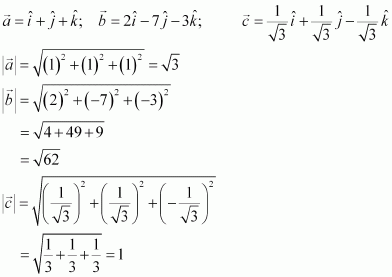
Q2 : Write two different vectors having same magnitude.
Answer :

Hence, ![]() are two different vectors having the same magnitude. The vectors are different because they have different directions.
are two different vectors having the same magnitude. The vectors are different because they have different directions.
Q3 : Write two different vectors having same direction.
Answer :
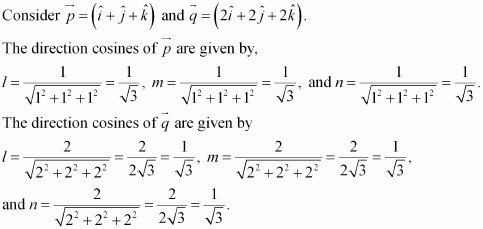
The direction cosines of ![]() are the same. Hence, the two vectors have the same direction.
are the same. Hence, the two vectors have the same direction.
Q4 : Find the values of x and y so that the vectors![]() are equal
are equal
Answer :
The two vectors![]() will be equal if their corresponding components are equal.
will be equal if their corresponding components are equal.
Hence, the required values of x and y are 2 and 3 respectively.
Q5 : Find the scalar and vector components of the vector with initial point (2, 1) and terminal point (-5, 7).
Answer :
The vector with the initial point P (2, 1) and terminal point Q (-5, 7) can be given by,

Hence, the required scalar components are â€"7 and 6 while the vector components are![]()
Q6 : Find the sum of the vectors![]() .
.
Answer :
The given vectors are.![]()

Q7 : Find the unit vector in the direction of the vector![]() .
.
Answer :
The unit vector![]() in the direction of vector
in the direction of vector![]() is given by
is given by![]() .
.

Q8 : Find the unit vector in the direction of vector![]() , where P and Q are the points
, where P and Q are the points
(1, 2, 3) and (4, 5, 6), respectively.
Answer :
The given points are P (1, 2, 3) and Q (4, 5, 6).

Hence, the unit vector in the direction of![]() is.
is.

Q9 : For given vector![]() and
and ![]() ,find the unit vector in the direction of vector
,find the unit vector in the direction of vector
![]()
Answer :The given vector are![]() and
and![]()
.gif)
Hence the unit vector in the direction
![]()
.
Q10 : Find a vector in the direction of vector![]() which has magnitude 8 units.
which has magnitude 8 units.
Answer :
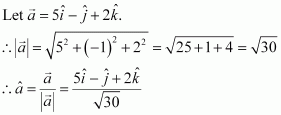
Hence, the vector in the direction of vector![]() which has magnitude 8 units is given by,
which has magnitude 8 units is given by,


Q11 : Show that the vectors![]() are collinear.
are collinear.
Answer :
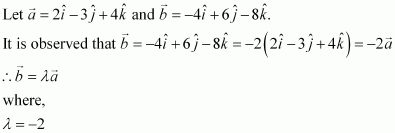
Hence, the given vectors are collinear.
Q12 : Find the direction cosines of the vector![]()
Answer :

Hence, the direction cosines of![]()
Q13 : Find the direction cosines of the vector joining the points A (1, 2, -3) and B (-1, -2, 1) directed from A to B.
Answer :
The given points are A (1, 2, â€"3) and B (â€"1, â€"2, 1).

Hence, the direction cosines of![]() are
are![]()
Q14 : Show that the vector![]() is equally inclined to the axes OX, OY, and OZ.
is equally inclined to the axes OX, OY, and OZ.
Answer :

Therefore, the direction cosines of![]()
Now, let α, β, and γbe the angles formed by with the positive directions of x, y, and z axes.
Then, we have![]()
Hence, the given vector is equally inclined to axes OX, OY, and OZ.
Q15 : Find the position vector of a point R which divides the line joining two points P and Q whose position vectors are![]() respectively, in the ration 2:1
respectively, in the ration 2:1
(i) internally
(ii) externally
Answer :
The position vector of point R dividing the line segment joining two points
P and Q in the ratio m: n is given by:
Internally:
![]()
Externally:
![]()
Position vectors of P and Q are given as:
![]()
(i) The position vector of point R which divides the line joining two points P and Q internally in the ratio 2:1 is given by,

(ii) The position vector of point R which divides the line joining two points P and Q externally in the ratio 2:1 is given by,

Q16 : Find the position vector of the mid point of the vector joining the points P (2, 3, 4) and Q (4, 1, – 2).
Answer :
The position vector of mid-point R of the vector joining points P (2, 3, 4) and Q (4, 1, -2) is given by,

Q17 : Show that the points A, B and C with position vectors,![]() ,
,![]() respectively form the vertices of a right angled triangle.
respectively form the vertices of a right angled triangle.
Answer :
Position vectors of points A, B, and C are respectively given as:
![]()
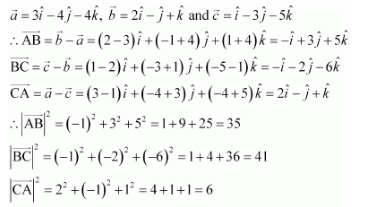
Q18 : In triangle ABC which of the following is not true:
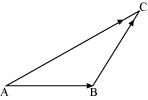
A.![]()
B.![]()
C.![]()
D.![]()
Answer :

On applying the triangle law of addition in the given triangle, we have:
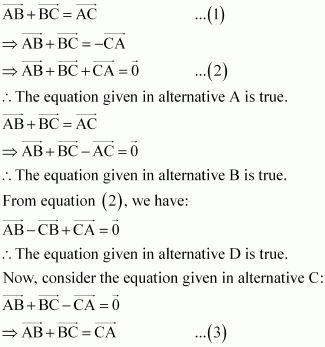
From equations (1) and (3), we have:
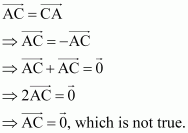
Hence, the equation given in alternative C is incorrect.
The correct answer is C.
Q19 : If![]() are two collinear vectors, then which of the following are incorrect:
are two collinear vectors, then which of the following are incorrect:
A.![]() , for some scalar λ
, for some scalar λ
B.![]()
C. the respective components of![]() are proportional
are proportional
D. both the vectors![]() have same direction, but different magnitudes
have same direction, but different magnitudes
Answer :
If![]() are two collinear vectors, then they are parallel.
are two collinear vectors, then they are parallel.
Therefore, we have:
![]() (For some scalar λ)
(For some scalar λ)
If λ = ±1, then ![]() .
.
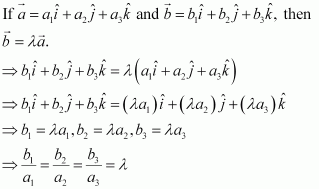
Thus, the respective components of![]() are proportional.
are proportional.
However, vectors![]() can have different directions.
can have different directions.
Hence, the statement given in D is incorrect.
The correct answer is D.
Exercise 10.3 : Solutions of Questions on Page Number : 447
Q1 : Find the angle between two vectors![]() and
and![]() with magnitudes
with magnitudes![]() and 2, respectively having
and 2, respectively having![]() .
.
Answer :
It is given that,
![]()
Now, we know that.![]()
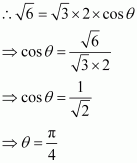
Hence, the angle between the given vectors![]() and
and![]() is
is![]() .
.
Q2 : Find the angle between the vectors![]()
Answer :
The given vectors are![]()
![]() .
.
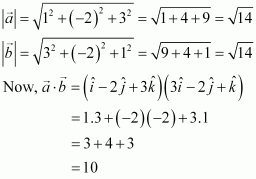
Also, we know that.![]()
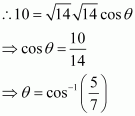
Q3 : Find the projection of the vector![]() on the vector
on the vector![]() .
.
Answer :
Let![]() and
and![]() .
.
Now, projection of vector![]() on
on![]() is given by,
is given by,

Hence, the projection of vector![]() on
on![]() is 0.
is 0.
Q4 : Find the projection of the vector![]() on the vector
on the vector![]() .
.
Answer :
Let![]() and
and![]() .
.
Now, projection of vector![]() on
on![]() is given by,
is given by,

Q5 : Show that each of the given three vectors is a unit vector:
![]()
Also, show that they are mutually perpendicular to each other.
Answer :
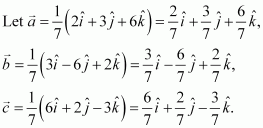
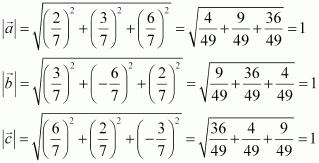
Thus, each of the given three vectors is a unit vector.
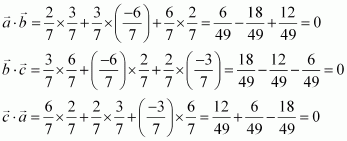
Hence, the given three vectors are mutually perpendicular to each other.
Q6 : Find![]() and
and![]() , if
, if![]() .
.
Answer :
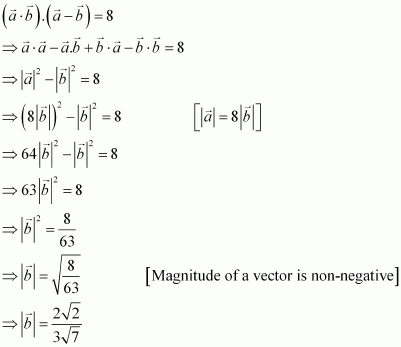
![]()
Q7 : Evaluate the product![]() .
.
Answer :
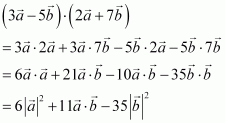
Q8 : Find the magnitude of two vectors![]() , having the same magnitude and such that the angle between them is 60° and their scalar product is
, having the same magnitude and such that the angle between them is 60° and their scalar product is![]() .
.
Answer :
Let θ be the angle between the vectors![]()
It is given that![]()
We know that![]() .
.
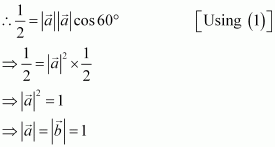
Q9 : Find![]() , if for a unit vector
, if for a unit vector![]() .
.
Answer :
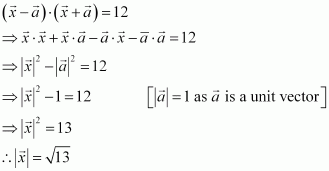
Q10 : If![]() are such that
are such that![]() is perpendicular to
is perpendicular to![]() , then find the value of λ.
, then find the value of λ.
Answer :
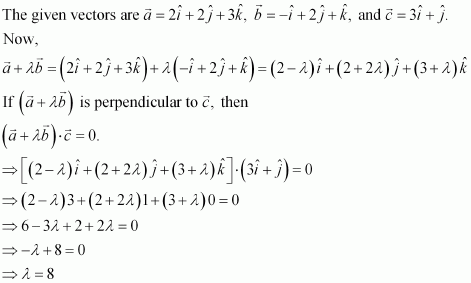
Hence, the required value of λ is 8.
Q11 : Show that![]() is perpendicular to
is perpendicular to![]() , for any two nonzero vectors
, for any two nonzero vectors![]()
Answer :
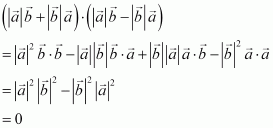
Hence, ![]() and
and![]() are perpendicular to each other.
are perpendicular to each other.
Q12 : If![]() , then what can be concluded about the vector
, then what can be concluded about the vector![]() ?
?
Answer :
It is given that.![]()

Hence, vector![]() satisfying
satisfying![]() can be any vector.
can be any vector.
Q13 : If![]() are unit vectors such that
are unit vectors such that![]() , find the value of
, find the value of ![]() .
.
Answer :
It is given that![]() .
.



From (1), (2) and (3),

Q14 : If either vector![]() , then
, then![]() . But the converse need not be true. Justify your answer with an example.
. But the converse need not be true. Justify your answer with an example.
Answer :

We now observe that:
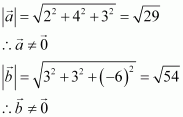
Hence, the converse of the given statement need not be true.
Q15 : If the vertices A, B, C of a triangle ABC are (1, 2, 3), (â€"1, 0, 0), (0, 1, 2), respectively, then find ∠ABC. [∠ABC is the angle between the vectors![]() and
and![]() ]
]
Answer :
The vertices of ΔABC are given as A (1, 2, 3), B (â€"1, 0, 0), and C (0, 1, 2).
Also, it is given that ∠ABC is the angle between the vectors![]() and
and![]() .
.
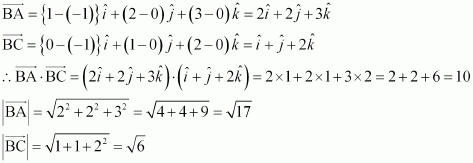
Now, it is known that:
![]()
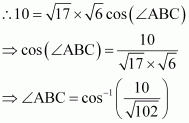
Q16 : Show that the points A (1, 2, 7), B (2, 6, 3) and C (3, 10, -1) are collinear.
Answer :
The given points are A (1, 2, 7), B (2, 6, 3), and C (3, 10, -1).
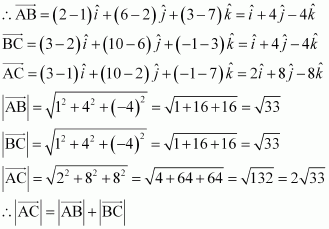
Hence, the given points A, B, and C are collinear.
Q17 : Show that the vectors![]() form the vertices of a right angled triangle.
form the vertices of a right angled triangle.
Answer :
Let vectors![]() be position vectors of points A, B, and C respectively.
be position vectors of points A, B, and C respectively.
![]()
Now, vectors![]() represent the sides of ΔABC.
represent the sides of ΔABC.
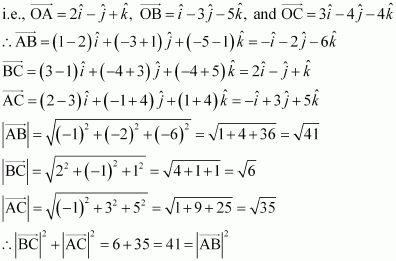
Hence, ΔABC is a right-angled triangle.
Q18 : If![]() is a nonzero vector of magnitude 'a' and λ a nonzero scalar, then λ
is a nonzero vector of magnitude 'a' and λ a nonzero scalar, then λ![]() is unit vector if
is unit vector if
(A) λ = 1 (B) λ = â€"1 (C)![]()
(D)![]()
Answer :
Vector![]() is a unit vector if
is a unit vector if![]() .
.
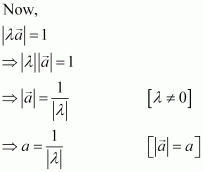
Hence, vector![]() is a unit vector if
is a unit vector if![]() .
.
The correct answer is D.
Exercise 10.4 : Solutions of Questions on Page Number : 454
Q1 : Find![]() , if
, if![]() and
and![]() .
.
Answer :
We have,
![]() and
and![]()
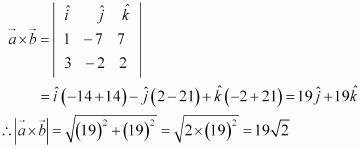
Q2 : Find a unit vector perpendicular to each of the vector![]() and
and![]() , where
, where![]() and
and![]() .
.
Answer :
We have,
![]()
and![]()
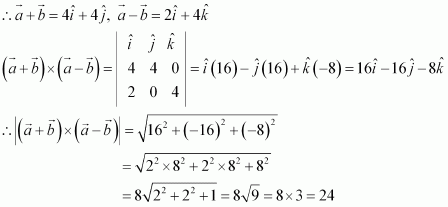
Hence, the unit vector perpendicular to each of the vectors
![]() and
and![]() is given by the relation,
is given by the relation,
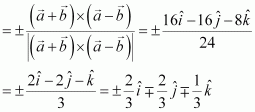
Q3 : If a unit vector![]() makes an angles
makes an angles![]() with
with![]() with
with![]() and an acute angle θ with
and an acute angle θ with![]() , then find θ and hence, the compounds of.
, then find θ and hence, the compounds of.
Answer :
Let unit vector![]() have (a1, a2, a3) components.
have (a1, a2, a3) components.
⇒![]()
Since![]() is a unit vector,
is a unit vector,![]() .
.
Also, it is given that![]() makes angles
makes angles![]() with
with![]() with
with![]() , and an acute angle θ with
, and an acute angle θ with![]()
Then, we have:
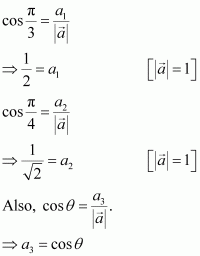

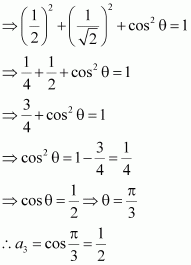
Hence,![]() and the components of
and the components of![]() are
are![]()
Q4 : Show that
![]()
Answer :

Q5 : Find λ and μ if ![]() .
.
Answer :
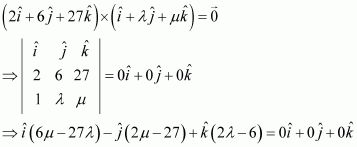
On comparing the corresponding components, we have:


Hence,![]()
Q6 : Given that![]() and
and![]() . What can you conclude about the vectors
. What can you conclude about the vectors![]() ?
?
Answer :
![]()
Then,
(i) Either![]() or
or![]() , or
, or![]()
![]()
(ii) Either![]() or
or![]() , or
, or![]()
But,![]() and
and![]() cannot be perpendicular and parallel simultaneously.
cannot be perpendicular and parallel simultaneously.
Hence,![]() or
or![]() .
.
Q7 : Let the vectors![]() given as
given as![]()
![]() . Then show that
. Then show that![]()
Answer :
We have,
![]()
![]()


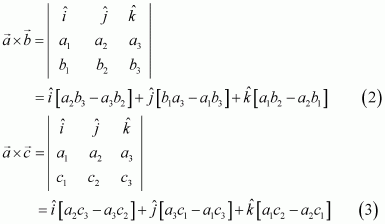
On adding (2) and (3), we get:

Now, from (1) and (4), we have:
![]()
Hence, the given result is proved.
Q8 : If either![]() or
or![]() , then
, then![]() . Is the converse true? Justify your answer with an example.
. Is the converse true? Justify your answer with an example.
Answer :
Take any parallel non-zero vectors so that![]() .
.
![]()

It can now be observed that:
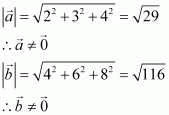
Hence, the converse of the given statement need not be true
Q9 : Find the area of the triangle with vertices A (1, 1, 2), B (2, 3, 5) and
C (1, 5, 5).
Answer :
The vertices of triangle ABC are given as A (1, 1, 2), B (2, 3, 5), and
C (1, 5, 5).
The adjacent sides![]() and
and![]() of ΔABC are given as:
of ΔABC are given as:
![]()
![]()
![]()
![]() Area of ΔABC
Area of ΔABC![]()

Hence, the area of ΔABC![]()
Q10 : Find the area of the parallelogram whose adjacent sides are determined by the vector ![]() .
.
Answer :
The area of the parallelogram whose adjacent sides are![]() is
is![]() .
.
Adjacent sides are given as:
![]()

Hence, the area of the given parallelogram is![]()
Q11 : Let the vectors![]() and
and![]() be such that
be such that![]() and
and![]() , then
, then![]() is a unit vector, if the angle between
is a unit vector, if the angle between![]() and
and![]() is
is
(A)![]() (B)
(B)![]() (C)
(C)![]() (D)
(D)![]()
Answer :
It is given that![]() .
.
We know that![]() , where
, where![]() is a unit vector perpendicular to both
is a unit vector perpendicular to both![]() and
and![]() and θ is the angle between
and θ is the angle between![]() and
and![]() .
.
Now,![]() is a unit vector if
is a unit vector if![]() .
.
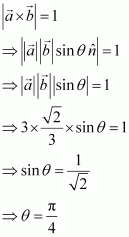
Hence,![]() is a unit vector if the angle between
is a unit vector if the angle between![]()
and![]() is
is![]() .
.
The correct answer is B.
Q12 : Area of a rectangle having vertices A, B, C, and D with position vectors![]() and
and![]() respectively is
respectively is
(A)![]() (B) 1
(B) 1
(C) 2 (D)4
Answer :
The position vectors of vertices A, B, C, and D of rectangle ABCD are given as:
![]()
The adjacent sides ![]() and
and![]() of the given rectangle are given as:
of the given rectangle are given as:
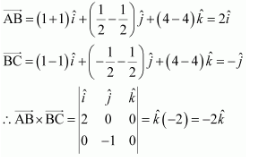
Exercise Miscellaneous : Solutions of Questions on Page Number : 458
Q1 : Write down a unit vector in XY-plane, making an angle of 30° with the positive direction of x-axis.
Answer :
If![]() is a unit vector in the XY-plane, then
is a unit vector in the XY-plane, then![]()
Here, θ is the angle made by the unit vector with the positive direction of the x-axis.
Therefore, for θ = 30°:
![]()
Hence, the required unit vector is![]() .
.
Q2 : Find the scalar components and magnitude of the vector joining the points![]() .
.
Answer :
The vector joining the points![]() can be obtained by,
can be obtained by,

Hence, the scalar components and the magnitude of the vector joining the given points are respectively
![]() and
and![]() .
.
Q3 : A girl walks 4 km towards west, then she walks 3 km in a direction 30° east of north and stops. Determine the girl's displacement from her initial point of departure.
Answer :
Let O and B be the initial and final positions of the girl respectively.
Then, the girl's position can be shown as:
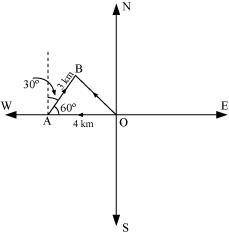
Now, we have:
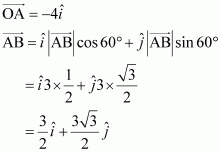
By the triangle law of vector addition, we have:
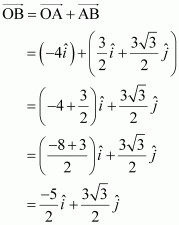
Hence, the girl's displacement from her initial point of departure is.
![]()
Q4 : If![]() , then is it true that
, then is it true that![]() ? Justify your answer.
? Justify your answer.
Answer :
![]()
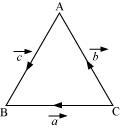
Now, by the triangle law of vector addition, we have![]() .
.
It is clearly known that represent the sides of ΔABC.
Also, it is known that![]() the sum of the lengths of any two sides of a triangle is greater than the third side.
the sum of the lengths of any two sides of a triangle is greater than the third side.
![]()
Hence, it is not true that![]() .
.
Q5 : Find the value of x for which![]() is a unit vector.
is a unit vector.
Answer :
![]() is a unit vector if
is a unit vector if![]() .
.
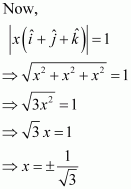
Hence, the required value of x is![]() .
.
Q6 : Find a vector of magnitude 5 units, and parallel to the resultant of the vectors![]() .
.
Answer :
We have,
![]()
Let![]() be the resultant of
be the resultant of![]() .
.
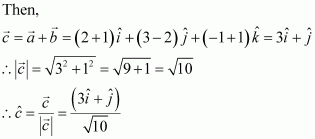
Hence, the vector of magnitude 5 units and parallel to the resultant of vectors![]() is
is
![]()
Q7 : If![]() , find a unit vector parallel to the vector
, find a unit vector parallel to the vector![]() .
.
Answer :
We have,
![]()
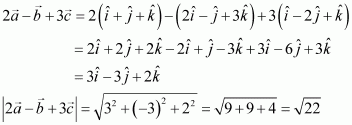
Hence, the unit vector along![]() is
is

Q8 : Show that the points A (1, -2, -8), B (5, 0, -2) and C (11, 3, 7) are collinear, and find the ratio in which B divides AC.
Answer :
The given points are A (1, â€"2, â€"8), B (5, 0, â€"2), and C (11, 3, 7).
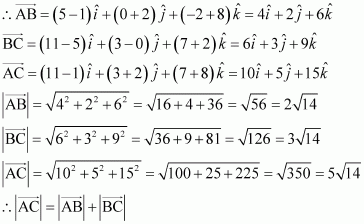
Thus, the given points A, B, and C are collinear.
Now, let point B divide AC in the ratio![]() . Then, we have:
. Then, we have:
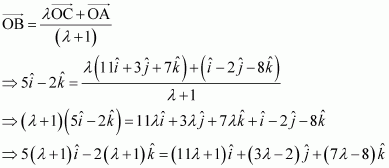
On equating the corresponding components, we get:
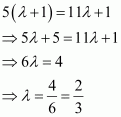
Hence, point B divides AC in the ratio
Q9 : Find the position vector of a point R which divides the line joining two points P and Q whose position vectors are![]() externally in the ratio 1: 2. Also, show that P is the mid point of the line segment RQ.
externally in the ratio 1: 2. Also, show that P is the mid point of the line segment RQ.
Answer :
It is given that![]() .
.
It is given that point R divides a line segment joining two points P and Q externally in the ratio 1: 2. Then, on using the section formula, we get:

Therefore, the position vector of point R is![]() .
.
Position vector of the mid-point of RQ =![]()
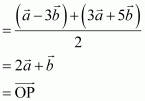
Hence, P is the mid-point of the line segment RQ.
Q10 : Show that the direction cosines of a vector equally inclined to the axes OX, OY and OZ are![]() .
.
Answer :
Let a vector be equally inclined to axes OX, OY, and OZ at angle α.
Then, the direction cosines of the vector are cos α, cos α, and cos α.
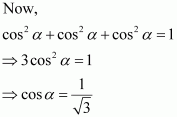
Hence, the direction cosines of the vector which are equally inclined to the axes are![]()
Q11 : Let![]() and
and![]() . Find a vector which is perpendicular to both and, and.
. Find a vector which is perpendicular to both and, and.
Answer :
Let.
Since Is perpendicular to both and, we have:
Also, it is given that:
On solving (i), (ii), and (iii), we get:
Hence, the required vector is.
Q12 : The scalar product of the vector with a unit vector along the sum of vectors and is equal to one. Find the value of.
Answer :
Therefore, unit vector along is given as:
Scalar product of with this unit vector is 1.
Hence, the value of λ is 1.
Q13 : If are mutually perpendicular vectors of equal magnitudes, show that the vector is equally inclined to and.
Answer :
Sincere mutually perpendicular vectors, we have
It is given that:
Let vector be inclined to at angles respectively.
Then, we have:
Now, as, .
Hence, the vector is equally inclined to.
Q14 : Prove that, if and only if are perpendicular, given.
Answer :
Q15 : If θ is the angle between two vectors![]() and , then only when
and , then only when
(A) (B)
(C) (D)
Answer :
Let θ be the angle between two vectors and.
Then, without loss of generality, and are non-zero vectors so that.
It is known that.
Hence, when.
The correct answer is B.
Q16 : Let ![]() and
and![]() be two unit vectors andθ is the angle between them. Then
be two unit vectors andθ is the angle between them. Then![]() is a unit vector if
is a unit vector if
(A)![]() (B)
(B)![]() (C)
(C)![]() (D)
(D)![]()
Answer :
Let![]() and
and![]() be two unit vectors andθ be the angle between them.
be two unit vectors andθ be the angle between them.
Then,![]() .
.
Now,![]() is a unit vector if
is a unit vector if![]() .
.
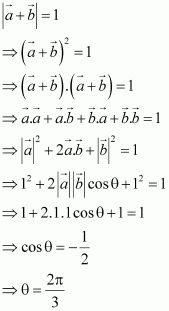
Hence,![]() is a unit vector if
is a unit vector if![]() .
.
The correct answer is D.
Q17 : The value of is![]()
(A) 0 (B) â€"1 (C) 1 (D) 3
Answer :
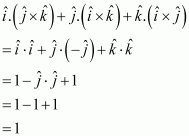
The correct answer is C.
Q18 : If θ is the angle between any two vectors![]() and
and![]() , then
, then![]() when θisequal to
when θisequal to
(A) 0 (B)![]() (C)
(C)![]() (D) π
(D) π
Answer :
Let θ be the angle between two vectors![]() and
and![]() .
.
Then, without loss of generality, ![]() and
and![]() are non-zero vectors, so that
are non-zero vectors, so that![]() .
.
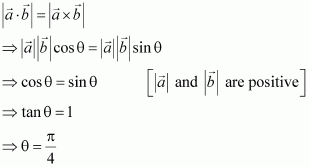
Hence,![]() when θisequal to
when θisequal to![]() .
.
The correct answer is B.
Cbse Class 12 Maths Ncert Solutions Chapter 10
Source: https://www.toppersbulletin.com/ncert-solutions-for-class-12-maths-maths-part-2-chapter-10/
0 Response to "Cbse Class 12 Maths Ncert Solutions Chapter 10"
Post a Comment